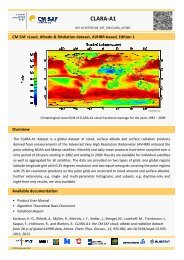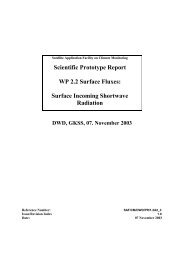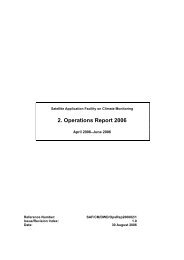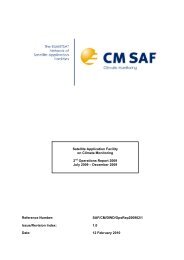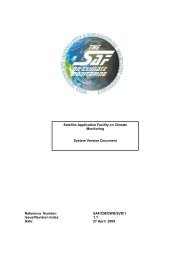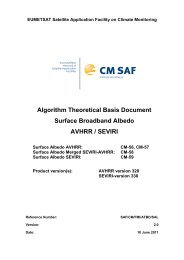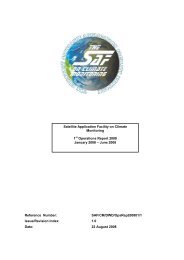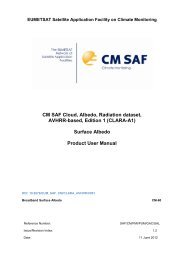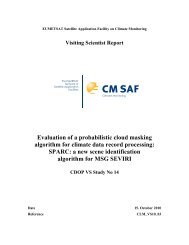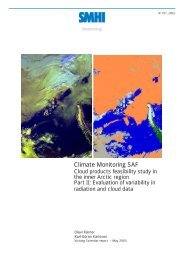Aerosol retrievals from METEOSAT-8 - CM SAF
Aerosol retrievals from METEOSAT-8 - CM SAF
Aerosol retrievals from METEOSAT-8 - CM SAF
Create successful ePaper yourself
Turn your PDF publications into a flip-book with our unique Google optimized e-Paper software.
<strong>SAF</strong> on Climate Monitoring Visiting Scientists Report Doc. No: 1.0<br />
Issue : 1.0<br />
Date : 4 October 2006<br />
Previous generations of geostationary meteorological satellites, such as <strong>METEOSAT</strong> and GOES<br />
have been widely used to monitor aerosol properties over oceans (Moulin et al., 1997). However,<br />
the spectral channels of the first generation <strong>METEOSAT</strong> were rather limited for accurate <strong>retrievals</strong><br />
of aerosol parameters. More advanced aerosol <strong>retrievals</strong> have been done with polar orbiting<br />
satellites such as NOAA-AVHRR, MERIS, SEAWIFS and MODIS (Ramon 2001, Ramon<br />
2004,and Kaufman and Tanre, 1997). The Spinning Enhanced Visible and Infrared Imager<br />
(SEVIRI) onboard Meteosat Second Generation operates channels in the visible and near IR<br />
wavelength regions that are similar to e.g. NOAA-AVHRR and MODIS. Therefore, the launch of<br />
the MSG family is a great opportunity to test new ideas for filling the gap between <strong>retrievals</strong> <strong>from</strong><br />
geostationary and polar orbiting satellites, as SEVIRI combines the specific advantages of the<br />
geostationary orbit and geometric, radiometric and spectroscopic capabilities of the<br />
NOAA/AVHRR family.<br />
The objective of this Visiting Scientist activity is to perform a user requirement and feasibility study<br />
to catch the main steps of a future operational algorithm for retrieving the aerosol optical properties<br />
over land <strong>from</strong> the MSG/SEVIRI instrument. For the feasibility study we kept the shortest time<br />
resolution available <strong>from</strong> MSG i.e. 15 minutes. This constraint could be relaxed in the future but we<br />
wanted to start with the strongest constraint. The short time for this study forced us to restrict<br />
ourselves to the main difficulty of all aerosol retrieval algorithms that are applied over land<br />
surfaces, i.e. the removal of the surface contribution to the satellite signal. This is needed for all<br />
existing sensors and aerosol retrieval algorithms. In this study our approach is to demonstrate,<br />
mainly through real data analysis, that the core idea of this future algorithm is correct and that<br />
significant results are achievable with very simple assumptions. However, the output of this study<br />
should not be taken neither as an Algorithm Theoretical Basis Document nor an algorithm<br />
specification document. A lot of crude assumptions have to be refined in order to reach a complete<br />
and robust algorithm. A very recent paper under press and not available at the beginning of the<br />
work draws very similar conclusions as ours but for the GOES sensor (Knapp et al. 2005).<br />
The user requirements for an aerosol product over land <strong>from</strong> SEVIRI are detailed in chapter 3. In<br />
chapter 4 the main algorithm classes and performances are briefly reviewed. Then we will explain<br />
in chapter 5 our methodology and show some first results. We will end in chapter 6 with giving<br />
some research directions and list all potential improvements we foresee at the moment.<br />
- 4 -



